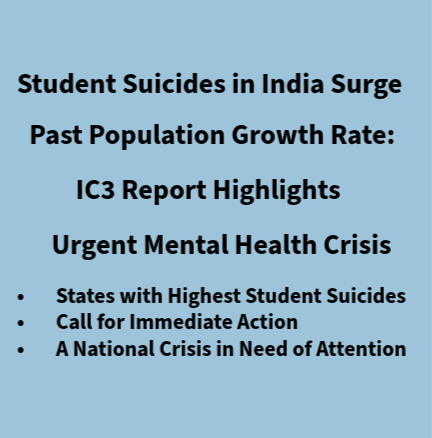New Delhi, Aug 29: A recent report titled “Student Suicides: An Epidemic Sweeping India,” launched at the Annual IC3 Conference and Expo 2024, has highlighted a disturbing trend in India. Based on data from the National Crime Records Bureau (NCRB), the report reveals that the rate of student suicides in India is growing at an alarming pace, far exceeding both the country’s population growth rate and the overall suicide rate, reported the NDTV.
While India’s overall suicide rate has seen a modest annual increase of 2 percent, the incidence of student suicides has surged by 4 percent, indicating a rise in mental health challenges among the younger population. Over the last 20 years, student suicides have increased annually by 4 percent, which is double the national average. In 2022, male students made up 53 percent of the total student suicides. Although there was a 6 percent decrease in male student suicides from 2021 to 2022, female student suicides saw a sharp rise of 7 percent in the same period.
The report, compiled by the IC3 Institute, notes that from 2012 to 2022, student suicides have risen dramatically – from 6,654 to 13,044 – despite a decrease in the 0-24 age group’s population from 582 million to 581 million. This stark increase underscores a grave concern that student suicides are outpacing population growth rates and overall suicide trends.
States with Highest Student Suicides
Maharashtra, Tamil Nadu, and Madhya Pradesh are the states with the highest number of student suicides, accounting for nearly a third of the national total. Southern states and union territories collectively contribute to 29 percent of these cases. Rajasthan, known for its rigorous academic environment, ranks 10th, reflecting the intense pressures associated with coaching hubs like Kota.
The report points out that the data compiled by the NCRB is based on police-recorded First Information Reports (FIRs). However, the actual numbers might be underreported due to social stigma and the criminalisation of attempted and assisted suicide under Section 309 of the Indian Penal Code. Although the 2017 Mental Healthcare Act decriminalises suicide attempts for individuals with mental illness, the legacy of criminalisation continues to impact reporting practices, especially in rural areas where data collection is inconsistent.
Call for Immediate Action
Ganesh Kohli, Founder of the IC3 Movement, emphasised the need to address mental health challenges within educational institutions.
“Our educational focus must shift to fostering competencies that support students’ overall well-being rather than pushing them to compete against one another,” he said.
Kohli called for a robust and comprehensive career and college counselling system in each institution to integrate mental health support seamlessly within the learning curriculum, reported the NDTV.
The report further indicates that both male and female student suicides have increased by an average of 5 percent annually over the last five years, with male suicides rising by 50 percent and female suicides by 61 percent over the past decade. These statistics underline the urgent need for improved counselling infrastructure and a deeper understanding of student aspirations.
A National Crisis in Need of Attention
The report from the IC3 Institute serves as a wake-up call for India’s education system to prioritise mental health support. As the incidence of student suicides continues to climb, addressing these gaps is essential to shift the focus from competitive pressures to nurturing core competencies and overall well-being. Without immediate and concerted efforts to improve mental health support, the crisis of student suicides in India will continue to grow, claiming more young lives and leaving lasting impacts on society.




